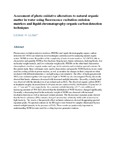| dc.description.abstract | Fluorescence excitation emission matrices (FEEMs) and liquid chromatography-organic carbon
detection (LC-OCD) are relatively novel techniques currently used for analysing natural organic
matter (NOM) in water. Regardless of the complexity of natural water matrices, LC-OCD is able to
characterize and quantify NOM as five fractions: biopolymers, humic substances, building blocks, low
molecular weight neutrals, and low molecular weight acids. FEEMs on the other hand characterize
chromophoric dissolved organic matter and map out its emission and excitation spectral contours. In
the current study, these techniques were used to characterize and quantify NOM fractions in raw water
used for cooling at Eskom power stations, as well as monitor the changes in their composition when
irradiated with different intensities of sunlight using a sun simulator. The effect of hydrogen peroxide
(H2O2) (an oxidant) together with exposure to light on NOM was also investigated. Firstly, the results
showed that humic substances decreased with increased sunlight intensities. Secondly, a similar trend
was observed with the introduction of an oxidant such as H2O2. The dissolved organic carbon (DOC)
in irradiated samples decreased from 9.100 ppm (in raw water) to 8.832, 8.838 and 8.175 ppm for 0.6
sun, 1.2 sun and 2.0 sun, respectively. At a constant sunlight intensity (of 1.2 sun), addition of
increasing amounts of 30% H2O2 showed that the distribution of NOM fractions changed significantly.
Generally, a decreasing trend in the molecular weight of NOM was observed with increased
irradiation intensity as well as increased oxidant amounts. The fluorescence signature peaks showed
that the humic substance (HS) contours changed but remained relatively stable with an increase in
light intensity. The results of the peroxide effect on humic substances showed disappearing spectral
signature peaks. No spectral contours in the HS region were formed for samples illuminated by near
natural sunlight intensity in the presence of H2O2. These results are particularly important in
understanding NOM in water used for cooling in power generation stations. | en_US |

